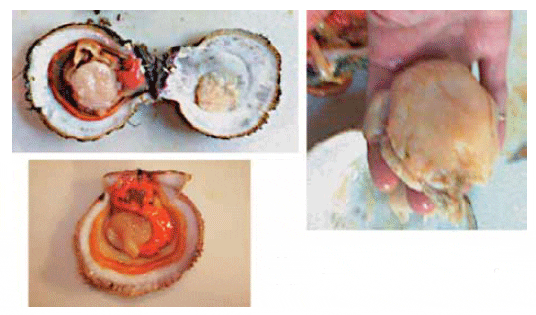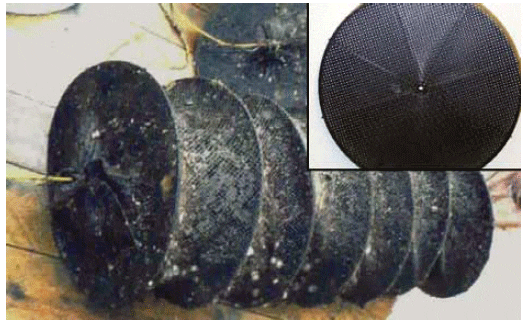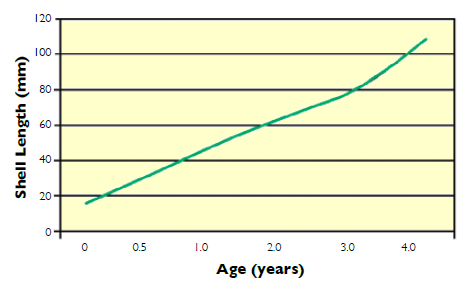
Scallop culture is a well-established
industry in some parts of the world. Japan
began investigating the potential for scallop
culture in the 1930s and started commercial
production in the mid-1960s.
Building on Japans success and borrowing
from the procedures developed there,
China and Chile began their own scallop
culture industries in the 1980s.
Additional small but developing culture
industries exist in eastern Canada,
Russia, Great Britain, France, Norway,
Ireland, Italy and Spain. In spite of the
success of scallop culture elsewhere in the
world, efforts in the United States fail to
meet domestic demand and remain limited
to small-scale operations.
Purple-Hinge Rock Scallops
In the waters of the U.S. state of
Alaska, the Pacific weathervane scallop,
Patinopecten caurinus, is the only commercially
harvested scallop species. The purple-hinge rock scallop, Crassadoma gigantean,
has potential for aquaculture, and is highly
prized by local communities and harvested
for subsistence in coastal Alaska.
Purple-hinge rock scallops are found
along the U.S. Pacific coast from Baja,
California, northward to Alaska, although
their distribution is patchy throughout the
range. Unlike their free-swimming pectinid
relatives, the scallops have developed
an affinity for permanent attachment. in
rocky substrates. This presents challenges
for commercial harvest, but is a potential
advantage for mariculture.
Aquaculture of purple-hinge rock scallops
has been investigated in California,
and while results were promising, there
were barriers to implementing commercial
culture operations. Research conducted in
1989 by Neil Bourne in British Columbia
showed promise for mariculture in a more
northerly location. Renewed interest in
Alaska resulted in a study by the authors that further determined the feasibility of
culturing this species.
Scallop Projects
A survey of Alaskas shellfish-farming
industry in 1997 recognized the importance
of species diversity, and the production
of high-value shellfish became a top
priority. In January 2006, an aquaculture
planning session sponsored by the governors
office again supported the development
of new species as a priority.
In response, the Alaska Sea Grant
Marine Program, Qutekcak Shellfish
Hatchery and Alaskan Shellfish Growers
Association invested in research on
hatchery production and field growout
trials to develop farming practices for the
purple-hinge rock scallop. Native to
Alaskan waters, purple-hinge rock scallops
are biologically suitable for aquaculture
and sell for over U.S. $3/scallop on
the local market.
Hatchery production research started
in 1997 with funding from the National
Marine Fisheries Services. Over a twoyear
period, multiple reproduction and
larval-rearing trials were performed, with
the first successes in 1999. In the following
year, a sizable population produced
enough seed to begin field growout trials.
The most significant challenge to the
hatchery was low survival from the pedivelliger
stage to a seed size of 7.5 mm.
Growout Work

The Alaska Science and Technology
Foundation has funded subsequent field
growout research since 2001, with purple-hinge rock scallop seed 31.1 mm in
shell length delivered to the Pearl of
Alaska farm near Kake in southeastern
Alaska. The scallops were nursery cultured
in lantern nets, where they reached
52 mm in length. Survival during this
initial phase was density dependent, varying
from 17% at a density of 300 scallops/
chamber to 50% when 100 scallops were
stocked per chamber. For growout, the
scallops were moved to nornets and raised
to 4.3 years of age. A nornet is a production
unit composed of a stack of rigid
perforated disks separated by about 10
cm and encased in netting. Scallop seeds
are placed on each disk.
Nornets were used because as scallops
grow, they incorporate the substrate into their bottom shells. With lantern nets, the
netting would be grown into the shells.
Removing scallops from the net would
require destroying the nets. The nornets
chamber flooring of thick, perforated plastic
prevents scallops from growing into the
webbing, simplifying sampling.
Measurements of the scallops adductor
muscles were taken at ages 2 and 4
years (Table 1). Shell growth for the
four-year period is shown in Figure 1.

Purple-hinge Rock Scallop Shell Growth Through Four Years of Growout.

Scallop Traits
While purple-hinge rock scallops are
locally prized, they would be a new species
for the seafood market where quality
assessment is necessary to promote
acceptance. Ten adult purple-hinge rock
scallops were harvested from pens at Elfin Cove Oysters in Port Althorp on
the north end of Chichagof Island in
southeast Alaska and shipped live to the
Fishery Industrial Technology Center in
Kodiak. The scallops were held at 4 C,
and processing was carried out within
two days of arrival.
The wet weights of whole scallops,
shells, gonadal-visceral (body) tissues and
adductor muscles were measured using an
electronic digital scale. Shell length,
width and depth, and adductor muscle
length and width were determined using
a cloth tape measure and electronic digital
calipers.
The scallops were shucked after whole
weights were recorded. The adductor
muscles were individually vacuum packed
and stored at -30 C until analysis. A muscle
condition index (MCI) assessing the
physiological condition of the adductor
muscle relative to total soft tissue was calculated
for the samples according to the
formula MCI (%) = weight of adductor
muscle/weight of total soft tissues x 100.
The purple-hinge rock scallop is a
large species with massive shells and large
adductor muscles (Table 2). The range of
the 10 specimen whole weights was 561 to 1,202 g. Shell heights ranged from 138
to 189 mm. Yields of edible adductor
muscle were less than 10%. However,
MCI values were between 36.0 and 50.9.
The results reflected observations
made by other researchers on the size and
condition of purple-hinge rock scallops.
Individuals can reach shell heights of 250
mm, and the shells become massive and
heavy. David Leighton reported purplehinge
rock scallop adductor muscle
weights from 50 to 80 g, and muscles at 30
to 55% of soft body weight, reported in
this study as MCI. In comparison, weathervane
scallops, which can also reach shell
heights of 250 mm, typically have adductor
muscles in the 27- to 48-g range and
yields of 10 to 12%.

Composition
The adductor muscle and digestive
gland are the primary storage sites of
nutrient reserves in scallops. Carbohydrate,
in the form of glycogen, and protein
are stored in the adductor muscle,
while lipid is stored in the digestive
gland. The gross composition of rock
scallops is shown in Table 3.
Purple-hinge scallop adductor muscle is lean due to its low lipid content. Lipids
in the muscle are mainly composed of
phospholipids. Furthermore, purple-hinge
scallop adductor muscle is an excellent
source of high-quality marine protein.
With regards to flavor, glycogen, together
with a variety of amino acids, impart desirable
sweetness to the product.
Perspectives
The purple-hinge scallop is a specialty
seafood item that provides an opportunity
for shellfish growers in Alaska to diversify
their farm production. The scallops can
easily fit in with suspended oyster farming.
The low water temperatures in Alaska
are not conducive to fast growth of shellfish,
but the pristine water quality yields
excellent product quality. Because of scallops
long growout period to market size,
research continues to develop growout
techniques that require minimal labor for
farmers.
June 2012
